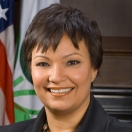
When I first became Administrator of the U.S. Environmental Protection Agency, I made a list of my priorities for the Agency. Working for environmental justice was at the top of that list. Ensuring equal environmental protections for all Americans is the unfinished business of the environmental movement.
It’s a simple idea – that all Americans are entitled to clean air to breathe, safe water to drink and a healthy community to raise their families – but often, it is America’s low-income and minority communities that bear the brunt of our country’s pollution.
As a result, these communities are also hit harder by the many illnesses pollution is linked to – conditions like asthma, heart disease, cancer and strokes. Studies show that minority groups face a greater risk of having asthma, and once they have it, they are at a greater risk of needing emergency treatment. African-American children are hospitalized for asthma at twice the rate of white children, and asthma-related deaths among African-American children take place at a rate of four times that of non-Hispanic white children. Hispanic children -- especially of Puerto Rican descent -- also face higher rates of asthma.
Dirty air, polluted water and contaminated lands not only put families at higher risks of serious and potentially costly diseases – they also discourage new developments and new jobs. Poison in the ground often means poison in the economy. Limiting the economic possibilities of low-income and minority communities only makes it harder to break the cycle of poverty.
Shortly after I was sworn in, I asked EPA employees to make environmental justice part of every decision we make. I called on the whole Agency to think creatively and work hard to make certain that our efforts reach all communities. Plan EJ 2014 – the environmental justice strategy we unveiled more than two years ago– is the tool we created for answering that call. It is aimed at ensuring that environmental justice is integrated into all of EPA’s day-to-day responsibilities – everything from permitting, compliance and enforcement, to community-based programs and the work we do with other federal agencies.
As I prepare to leave EPA, one of my last acts as administrator is issuing the Plan EJ 2014 Progress Report. The report provides ample evidence of how far we have come in making environmental justice an integral and permanent part of EPA’s day-to-day business. It also details how we have mobilized the entire federal government to incorporate environmental justice into the work each agency conducts.
For the first time in our 42 year history, we have laid the groundwork for EPA to fully implement its environmental justice mission of ensuring environmental protection for all Americans, regardless of race, ethnicity or income level. I am proud of the work we have started and the progress we have made, and I am confident that it will continue long after I depart.


